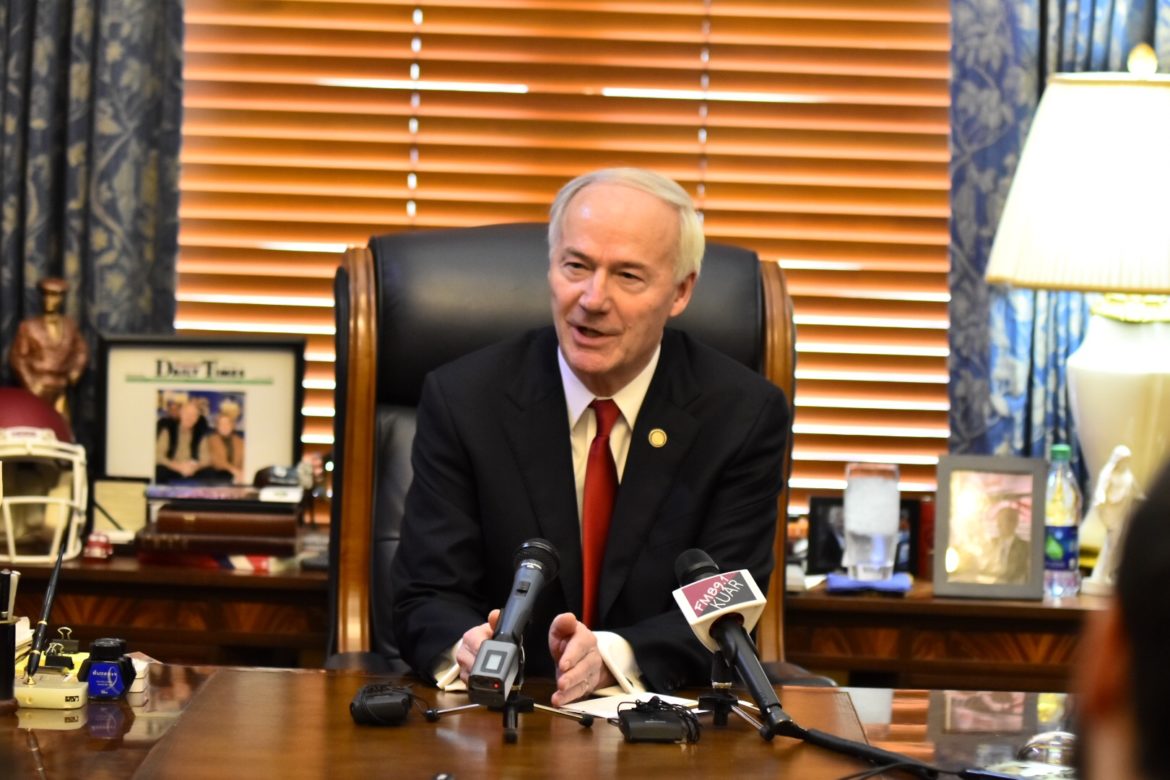Some 908,900 Arkansans may become infected with the novel coronavirus over the course of the next six months, according to an epidemiological model of the spread of COVID-19 in Arkansas provided by the Arkansas Hospital Association to its members. Among those who become infected, an estimated 190,800 Arkansans may need hospital care and 41,400 may need to be hospitalized in intensive care units in the next six months, according to the projections.
The model, which was obtained by the Arkansas Nonprofit News Network and which the AHA later confirmed it produced, assumes a statewide 40 percent infection rate over the course of six months and puts hospitalization at the peak of the pandemic — in June — at 12,720 beds. There are around 8,400 staffed hospital beds in Arkansas.
The AHA’s numbers were based on a model designed by infectious disease epidemiologists at Harvard University.
Asked about the projections on Thursday, Governor Hutchinson said he and Secretary of Health Dr. Nathaniel Smith had spent a lot of time on modeling.
"The first thing you realize is that there are a lot of different models that are out there," he said. "We’re learning day-by-day more information. We're going to continue that effort. When we have confidence on it, we’ll act on it."
The Arkansas Department of Health was making new calculations Thursday, spokeswoman Meg Mirivel said.
Governor Hutchinson also reiterated a previous prediction that 1,000 people may be hospitalized with the coronavirus at the peak of the pandemic in Arkansas.
"If we do all the right things and we take the right protective measures, then when we get to the peak we’re probably looking at 1,000 individuals hospitalized," he said. "The key thing is that we do the right thing. As it changes, if we see it increasing at a faster rate, if we don’t see the public doing what they need to be doing, we can adjust accordingly."
The AHA model’s 40 percent infection rate is based on the “continuation of moderate, primarily voluntary social distancing measures.” Arkansas has closed certain things — schools, restaurants, bars, salons, park visitor centers, tattoo parlors — but Governor Hutchinson has been reluctant to close manufacturing and other businesses. Restaurants and bars are still allowed to offer take-out.
The figures in the AHA model assume a decrease in baseline occupancy rates at hospitals because of the pause in elective procedures. They are “are informed by the speed of epidemic growth observed so far in Arkansas, current public health practice and social distancing measures in the state, research on the behavior of novel viruses in previous pandemics, modeling specific to the spread of SARS-COV-2, and observations of the spread of the virus in other jurisdictions,” the report says.
Peggy Abbott, CEO of Ouachita County Medical Center in Camden, participated in a conference call with AHA members and the health department Thursday.
“The potential for the surge numbers to be greater than we’ve been publicly preparing for has always been a possibility,” she said.
She commended state leaders for taking the pandemic seriously and said she believed people in the state were complying with state directives on social distancing and limiting group gatherings.
“I think that has helped slow things. I think [state leaders] have been matter of fact and clear with what the potential is and tried to remain calm and not create panic or fear. That’s what we've tried to do is keep a calm, conservative approach to it.”
UAMS Health CEO Dr. Stephen Mette said the AHA model needs “more assessment,” Leslie Taylor, vice chancellor for communications and marketing, said today.
UAMS has seven COVID-19 patients, some of which are in ICU. The medical center has 51 ICU beds and 31 are occupied. Taylor said that the hospital has prepared for additional COVID-19 patients by outfitting other rooms with negative pressure (keeping airflow within the room) and equipment needed to treat respiratory illness.
In confirming the report, AHA spokeswoman Ashley Warren said the projections, distributed to member hospital leadership for planning purposes, indicate the hospital association’s concerns “are not misplaced.” She cited a Kaiser Family Foundation study that found that 47 percent of Arkansans are at a higher risk of serious illness if infected with the novel coronavirus — higher than the national average — because of our population’s “underlying health conditions.”
Lindsey Millar contributed reporting.
This reporting is courtesy of the Arkansas Nonprofit News Network, an independent, nonpartisan news project dedicated to producing journalism that matters to Arkansans.
